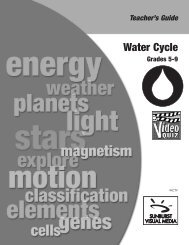Thrilling Experiments: Potential and Kinetic Energy
Thrilling Experiments: Potential and Kinetic Energy
Thrilling Experiments: Potential and Kinetic Energy
You also want an ePaper? Increase the reach of your titles
YUMPU automatically turns print PDFs into web optimized ePapers that Google loves.
Script<br />
JUNE<br />
Now, we have the mass for each ball. So, we’re ready to figure the kinetic energy<br />
of the basketball. The mass of the basketball is 590 grams. We have determined<br />
the velocity to be .37 meters per second. Don’t forget to square the velocity, that<br />
becomes .137. Now take our mass of 590 <strong>and</strong> multiply it times .137, our product<br />
is 80.83. .5 times this amount will give us 40.42, the kinetic energy of the<br />
basketball!<br />
Very good, everybody! That number is measured in Joules or Newton Meters. The<br />
largest number will indicate which ball has the most kinetic energy. Now with the<br />
same data from this experiment you can figure out the potential energy too.<br />
TONY<br />
OK lets insert our data into this equation. The masses are the same. Gravity is<br />
always 9.8 meters per second per second. The height is the height of our ramp.<br />
JUNE<br />
Correct Tony. Let’s find the potential energy of the basketball. The mass was 590<br />
grams. Gravity, as you said, is 9.8 meters per second. The height of our ramp is<br />
.10 meters. Multiply 9.8 times .10, <strong>and</strong> we come up with .98. Now multiply 590<br />
times .98 <strong>and</strong> we have our potential energy of 578.2! Try it yourself!<br />
TONY<br />
Yeah, that experiment was filled with tons of interesting information. Now we<br />
know how to calculate kinetic <strong>and</strong> potential energy.<br />
JUNE<br />
Moving on, do you remember The Law of Conservation of <strong>Energy</strong>, Tony?<br />
TONY<br />
Yes I do. The law basically says that energy cannot be created or destroyed. It can<br />
be changed into another form of energy, but the amount of energy never changes.<br />
EXPERIMENT #4: UNDERSTANDING THE LAW OF<br />
CONSERVATION OF ENERGY<br />
JUNE<br />
In our next experiment, we will produce a pendulum to illustrate the Law of<br />
Conservation.<br />
© Sunburst Visual Media, a division of Global Video, LLC <strong>Thrilling</strong> <strong>Experiments</strong>: <strong>Potential</strong> <strong>and</strong> <strong>Kinetic</strong> <strong>Energy</strong><br />
53











